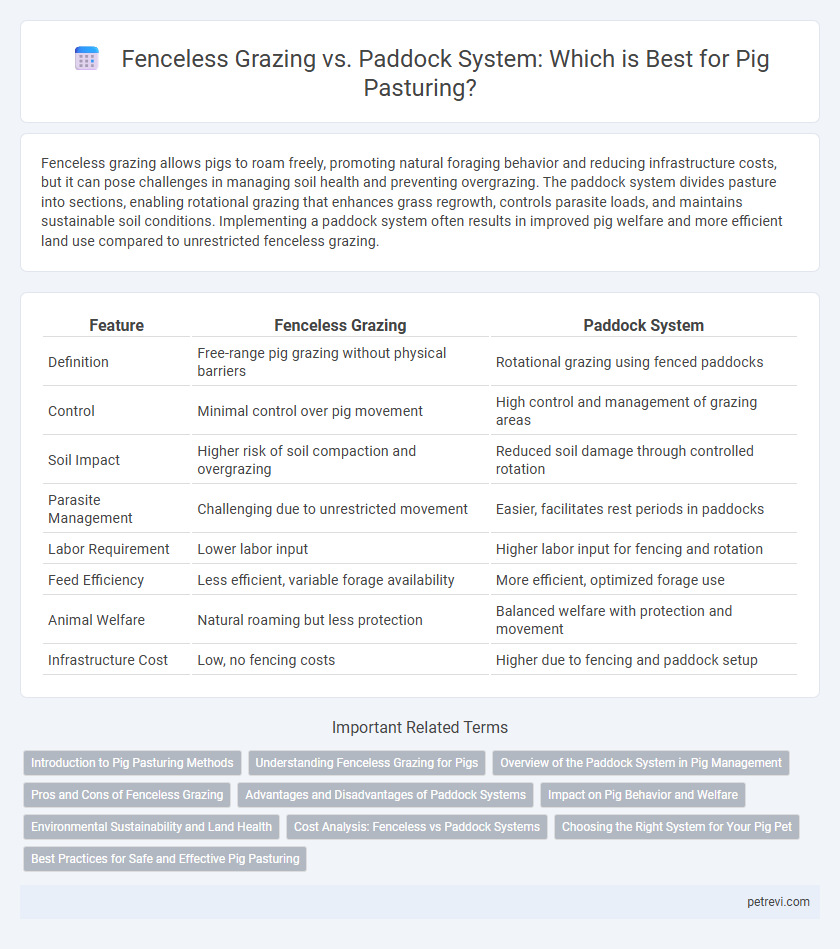Fenceless grazing allows pigs to roam freely, promoting natural foraging behavior and reducing infrastructure costs, but it can pose challenges in managing soil health and preventing overgrazing. The paddock system divides pasture into sections, enabling rotational grazing that enhances grass regrowth, controls parasite loads, and maintains sustainable soil conditions. Implementing a paddock system often results in improved pig welfare and more efficient land use compared to unrestricted fenceless grazing.
Table of Comparison
| Feature | Fenceless Grazing | Paddock System |
|---|---|---|
| Definition | Free-range pig grazing without physical barriers | Rotational grazing using fenced paddocks |
| Control | Minimal control over pig movement | High control and management of grazing areas |
| Soil Impact | Higher risk of soil compaction and overgrazing | Reduced soil damage through controlled rotation |
| Parasite Management | Challenging due to unrestricted movement | Easier, facilitates rest periods in paddocks |
| Labor Requirement | Lower labor input | Higher labor input for fencing and rotation |
| Feed Efficiency | Less efficient, variable forage availability | More efficient, optimized forage use |
| Animal Welfare | Natural roaming but less protection | Balanced welfare with protection and movement |
| Infrastructure Cost | Low, no fencing costs | Higher due to fencing and paddock setup |
Introduction to Pig Pasturing Methods
Fenceless grazing for pig pasturing allows animals to roam freely over large areas, promoting natural rooting behavior and soil aeration without the restriction of physical barriers. The paddock system divides pastures into smaller, controlled sections to prevent overgrazing and facilitate rotational grazing, enhancing pasture recovery and nutrient distribution. Both methods aim to optimize pig welfare and pasture sustainability but differ in management intensity and land use efficiency.
Understanding Fenceless Grazing for Pigs
Fenceless grazing for pigs involves allowing animals to forage freely without physical barriers, relying on controlled access and natural boundaries to manage movement and grazing patterns. This system promotes natural behaviors and can improve soil health, but requires careful monitoring to prevent overgrazing and ensure pig safety. Compared to the paddock system, which uses rotational grazing with defined enclosures, fenceless grazing offers greater flexibility but demands more intensive management to balance pasture sustainability and animal welfare.
Overview of the Paddock System in Pig Management
The paddock system in pig pasturing divides grazing land into multiple fenced sections, allowing controlled rotation and rest periods that promote pasture regrowth and parasite management. This method optimizes forage utilization, reduces soil compaction, and improves pig health by minimizing exposure to concentrated waste and pathogens common in continuous fenceless grazing. Research indicates that strategic paddock rotation supports sustainable pig production by enhancing nutrient cycling and reducing environmental impact.
Pros and Cons of Fenceless Grazing
Fenceless grazing in pig pasturing enhances natural foraging behavior and reduces fencing costs, promoting animal welfare and lowering initial investment. However, it poses risks such as increased predation, difficulty in controlling grazing area, and potential overuse of specific vegetation, leading to soil degradation. This system requires careful monitoring and strategic management to balance sustainability and animal health.
Advantages and Disadvantages of Paddock Systems
Paddock systems for pig pasturing offer controlled grazing which improves pasture regrowth, reduces soil erosion, and allows better manure distribution, enhancing soil fertility. However, these systems require higher initial investment, increased labor for fence setup and rotation management, and may restrict pigs' natural rooting behavior compared to fenceless grazing. Optimal paddock management balances productivity with animal welfare and environmental sustainability.
Impact on Pig Behavior and Welfare
Fenceless grazing allows pigs to exhibit natural foraging behaviors and socialize freely, promoting mental stimulation and reducing stress. The paddock system confines pigs to limited areas, which can restrict movement and foraging opportunities, potentially leading to boredom and aggressive behaviors. Studies show that rotational paddock grazing improves land recovery but may require enrichment strategies to maintain pigs' welfare effectively.
Environmental Sustainability and Land Health
Fenceless grazing for pigs reduces soil compaction and promotes natural vegetation recovery by allowing free-range movement, enhancing biodiversity and reducing erosion risks. The paddock system concentrates pig activity in designated areas, minimizing overgrazing and enabling land rest periods, which improves nutrient cycling and soil structure. Both methods support environmental sustainability but vary in land health outcomes depending on pasture management intensity and herd size.
Cost Analysis: Fenceless vs Paddock Systems
Fenceless grazing for pigs eliminates the need for investment in fencing materials and installation, reducing upfront costs significantly compared to the paddock system, which requires durable fencing and regular maintenance. However, paddock systems can improve pasture utilization and control pig movement, potentially lowering feed costs and enhancing soil health, resulting in long-term economic benefits that may offset higher initial expenses. Careful cost-benefit analysis reveals that fenceless grazing suits low-budget operations, while paddock systems offer greater returns through improved efficiency and sustainability in pig pasturing.
Choosing the Right System for Your Pig Pet
Fenceless grazing for pig pets promotes natural foraging behavior and reduces fencing costs, but requires large, predator-safe outdoor areas to prevent escape and ensure safety. The paddock system offers controlled grazing with rotational pasture access, improving soil health and minimizing parasite buildup, ideal for smaller spaces or urban settings. Evaluating available land, predator risks, and maintenance capacity helps determine the optimal pig pasturing method that balances animal welfare and management efficiency.
Best Practices for Safe and Effective Pig Pasturing
Fenceless grazing in pig pasturing requires strategic placement of natural barriers and rotational grazing to prevent overgrazing and ensure pig safety. The paddock system enhances biosecurity and soil health by confining pigs to smaller, managed areas, reducing parasite loads and allowing for effective manure distribution. Combining controlled access with regular soil monitoring optimizes pig health and pasture regeneration, representing best practices for sustainable pig pasturing.
Fenceless grazing vs Paddock system for Pig pasturing Infographic

 petrevi.com
petrevi.com